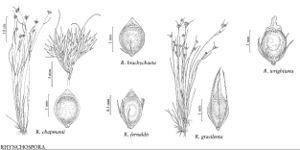Rhynchospora chapmanii
Amer. J. Sci. Arts, ser. 2, 7: 409. 1849.
Plants perennial, densely cespitose, 30–50(–70) cm; rhizomes absent. Culms erect to excurved, filiform, leafy, stiff to lax. Leaves mostly slightly exceeded by culm; blades ± filiform, proximally flat to concave, distally tapering, to 1 mm wide, margins involute, apex trigonous, subulate. Inflorescences terminal; spikelet clusters 1(–2), dense, broadly turbinate to hemispheric; longer leafy bracts 1–2(–several), setaceous, overtopping inflorescence. Spikelets light brown, narrowly ovoid, 2–2.5(–3) mm, apex acute or acuminate; fertile scales 1.5–2(–2.5) mm, apex acute, midrib excurrent as cusp or awn 0.5–0.9 mm. Flowers: bristles absent, rarely reduced to nubbins, or rarely 1, then shorter than fruit body. Fruits 1 per spikelet, 1–1.8 mm; body with dark brown ends, broad pale midzone, lenticular, ± orbicular, 1–1.2 × 0.8–1 mm, surfaces smooth; margins sharp, flowing to tubercle; tubercle lowtriangular, 0.2–0.3(–0.5) mm, sometimes apiculate.
Phenology: Fruiting summer–fall;
Elevation: 0–200 m
Distribution

Ala., Fla., Ga., La., Miss., N.C., S.C.
Discussion
Rhynchospora chapmanii is a frequent invader of logged or otherwise disturbed pine savannas, often an aspect dominant. Its pale inflorescences are conspicuous masses in autumn.
Selected References
None.
